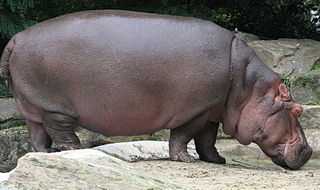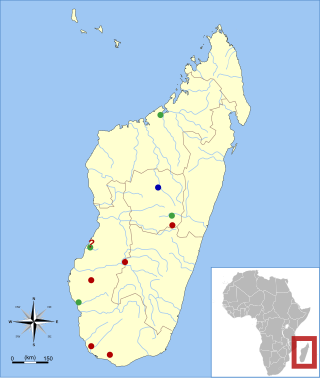
The hippopotamus (; ‹The template Plural form is being considered for merging.› pl.: hippopotamuses; often shortened to hippo, further qualified as the common hippopotamus, Nile hippopotamus, or river hippopotamus, is a large semiaquatic mammal native to sub-Saharan Africa. It is one of only two extant species in the family Hippopotamidae, the other being the pygmy hippopotamus. Its name comes from the ancient Greek for "river horse".

Hippopotamidae is a family of stout, naked-skinned, and semiaquatic artiodactyl mammals, possessing three-chambered stomachs and walking on four toes on each foot. While they resemble pigs physiologically, their closest living relatives are the cetaceans. They are sometimes referred to as hippopotamids.

The pygmy hippopotamus or pygmy hippo is a small hippopotamid which is native to the forests and swamps of West Africa, primarily in Liberia, with small populations in Sierra Leone, Guinea, and Ivory Coast. It has been extirpated from Nigeria.

Hippopotamus is a genus of artiodactyl mammals consisting of one extant species, Hippopotamus amphibius, the river hippopotamus, and several extinct species from both recent and prehistoric times. It belongs to the family Hippopotamidae, which also includes the pygmy hippopotamus and a number of extinct genera.

Plesiorycteropus, also known as the bibymalagasy or Malagasy aardvark, is a recently extinct genus of mammals from Madagascar. Upon its description in 1895, it was classified with the aardvark, but more recent molecular evidence instead suggests that it is most closely related to the tenrecs. Two species are currently recognized, the larger P. madagascariensis and the smaller P. germainepetterae. They probably overlapped in distribution, as subfossil remains of both species have been found in the same site.

Palaeopropithecus is a recently extinct genus of large sloth lemurs from Madagascar related to living lemur species found there today. Three species are known, Palaeopropithecus ingens, P. maximus, and P. kelyus. Radiocarbon dates indicate that they may have survived until around 1300–1620 CE. Malagasy legends of the tretretretre or tratratratra are thought to refer to P. ingens.

The fauna of Madagascar is a part of the wildlife of Madagascar.

Hippopotamus gorgops is an extinct species of the genus Hippopotamus known from remains found in Northern Africa, Eastern Africa, and the Levant. One of the largest hippopotamus species, it first appeared during the late Pliocene-Early Pleistocene, and became extinct during the early Middle Pleistocene.

Whippomorpha or Cetancodonta is a group of artiodactyls that contains all living cetaceans and the hippopotamids. All whippomorphs are descendants of the last common ancestor of Hippopotamus amphibius and Tursiops truncatus. This makes it a crown group. Whippomorpha is a suborder within the order Artiodactyla. The placement of Whippomorpha within Artiodactyla is a matter of some contention, as hippopotamuses were previously considered to be more closely related to Suidae (pigs) and Tayassuidae (peccaries). Most contemporary scientific phylogenetic and morphological research studies link hippopotamuses with cetaceans, and genetic evidence has overwhelmingly supported an evolutionary relationship between Hippopotamidae and Cetacea. Modern whippomorphs all share a number of behavioural and physiological traits; such as a dense layer of subcutaneous fat and largely hairless bodies. They exhibit amphibious and aquatic behaviors and possess similar auditory structures.

The Cypriot pygmy hippopotamus is an extinct species of dwarf hippopotamus that inhabited the island of Cyprus from the Pleistocene until the early Holocene. One the smallest known hippopotamus species, it was comparable in size to the living pygmy hippopotamus though it was more closely related to the common hippopotamus, with its small body size a result of insular dwarfism. It represented one of only two large terrestrial mammals on Cyprus alongside the Cyprus dwarf elephant. The species became extinct around 12,000 years ago following the arrival of humans on Cyprus, and potential evidence of human hunting has been found at the Aetokremnos rockshelter on the southern coast of the island.
Hippopotamus melitensis is an extinct hippopotamus from Malta. It lived during Middle-Late Pleistocene. It probably descended from Hippopotamus pentlandi from Sicily, which in turn probably descended from the common hippopotamus. Like Hippopotamus pentlandi, Hippopotamus melitensis is substantially smaller than H. amphibius as a result of insular dwarfism, having an estimated mass of approximately 900 kg, which is smaller than the 1100 kg estimated for H. pentlandi. The diet of H. melitensis is suggested to have been more generalist than Hippopotamus amphibius, likely as a result of limited resource diversity and lack of competition, as the only other large herbivore on the island was the dwarf elephant Palaeoloxodon mnaidriensis. The majority of findings of this species are from Għar Dalam, a cave on Malta famous for its Pleistocene fossil deposits.

Hippopotamus pentlandi is an extinct species of hippopotamus from Sicily, known from the late Middle Pleistocene to early Late Pleistocene. It is the largest of the insular dwarf hippos known from the Pleistocene of the Mediterranean, "at most 20% smaller than the mainland forms", with an estimated body mass of approximately 1100 kg. It is suggested that it arrived in Sicily between 250,000 and 150,000 years ago, probably descending from the modern hippopotamus, with an origin from Hippopotamus antiquus being less likely. In comparison to those species, the muzzle was shorter, the occipital and nasal regions were more developed, the mastoid process was enlarged, and the dental row was shortened, and the condyle of the mandible is low. In comparison to H. amphibius, the orbits are also elevated. It was present in Sicily until at least the latest Middle Pleistocene around 120 kya, and was probably extinct by the beginning of Marine Isotope Stage 4. Contemporaneous species include the dwarf elephant Palaeoloxodon mnaidriensis, the aurochs, red deer, steppe bison, fallow deer, wild boar, brown bear, wolves, red foxes, cave hyena and cave lions. Its diet was likely grazing dominated, similar to that of modern H. amphibius. It is probably ancestral to Hippopotamus melitensis from Malta, which is substantially smaller than H. pentlandi.

Lemerle's dwarf hippopotamus is an extinct species of Malagasy hippopotamus.

Cryptoprocta spelea, also known as the giant fossa, is an extinct species of carnivore from Madagascar in the family Eupleridae which is most closely related to the mongooses and includes all Malagasy carnivorans.

Several species of Malagasy hippopotamus lived on the island of Madagascar but are now believed to be extinct. The animals were very similar to the extant hippopotamus and pygmy hippopotamus. The fossil record suggests that at least one species of hippopotamus lived until about 1,000 years ago and other evidence suggests that the species may have survived until much more recently. The taxonomy of these animals is not resolved and not widely studied.

Voay is an extinct genus of crocodile from Madagascar that lived during the Late Pleistocene to Holocene, containing only one species, V. robustus. Numerous subfossils have been found, including complete skulls, noted for their distinctive pair of horns on the posterior, as well as vertebrae and osteoderms from such places as Ambolisatra and Antsirabe. The genus is thought to have become extinct relatively recently. It has been suggested to have disappeared in the extinction event that wiped out much of the endemic megafauna on Madagascar, such as the elephant bird and Malagasy hippo, following the arrival of humans to Madagascar around 2000 years ago. Its name comes from the Malagasy word for crocodile.

Hypogeomys australis is an extinct rodent from central and southeastern Madagascar. First described in 1903, it is larger than its close relative, the living Hypogeomys antimena, which occurs further west, but otherwise similar. Average length of the femur is 72.1 mm, compared to 63.8 mm in H. antimena. One of the few extinct rodents of Madagascar, it survived to at least around 1536 BP based on radiocarbon dating. Little is known of its ecology, but it may have lived in burrows like its living relative and eaten some arid-adapted plants.
H. madagascariensis may refer to:

Hippopotamus madagascariensis, the Madagascar or Madagascan dwarf hippopotamus, is an extinct species of hippopotamus, endemic to the island of Madagascar. Known only from bones, it is believed to have gone extinct sometime after 1500. It was one of three hippopotamus species, the Malagasy hippopotamuses, which were native to Madagascar and are all extinct.

















